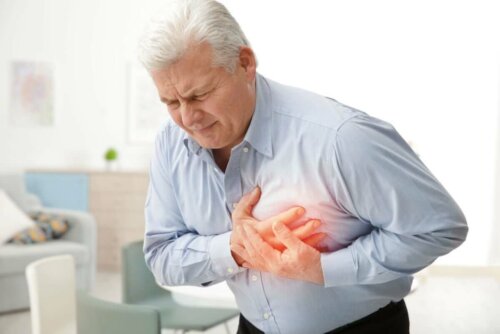6 Types of Heart Disease and the Symptoms They Cause

Numerous conditions or types of heart disease affect the heart or the blood vessels. They’re very common and are the main cause of death in several countries.
Unfortunately, according to the World Health Organization (WHO), 30% of deaths registered in 2017 were due to cardiovascular disorders. It isn’t surprising that any disease that alters the functioning of the heart is of great concern. For this reason, in this article, we’ll mention the most common ones and their main symptoms.
1. Hypertension
One of the most common types of heart disease is high blood pressure or hypertension. Under normal conditions, blood exerts a specific pressure against the walls of blood vessels, called blood pressure.
In several situations, this pressure can be so high that it can damage the body’s organs. It may be due to an increase in the volume of circulating blood or a decrease in the diameter of the arteries.
According to data from the European Society of Cardiology, a person with systolic blood pressure greater than 140 mmHg or diastolic blood pressure greater than 90 mmHg suffers from hypertension. Fortunately, this condition is easy to diagnose and the treatment is quite accessible.
Read on to learn more: 5 Natural Foods for Controlling Hypertension
Symptoms
This condition doesn’t cause specific symptoms. Thus, many people can suffer from it without even knowing it. However, some patients suffer various symptoms when their blood pressure goes up. These include headaches, dizziness, shortness of breath, and nosebleeds.
However, all of these symptoms are nonspecific, which is why doctors rarely attribute them to high blood pressure.

2. Coronary heart disease (CHD)
Coronary heart disease is a condition that affects the arteries responsible for supplying blood to the heart. The lumen of the blood vessels is reduced for various reasons, which leads to an insufficient supply of oxygen and blood to the heart.
Atheromatous plaque is one of the main causes of decreased arterial diameter. These are lipid or fat formations that build up on the walls of the arteries, which can break off and completely block a vessel.
One of the most common complications of this disease is myocardial infarction (MI), also known as a heart attack. It occurs when the artery is completely blocked, meaning there’s an inadequate blood supply. As a result, the cells don’t have enough oxygen and die within minutes.
Symptoms
The main symptom of coronary heart disease is angina pectoris or chest pain. In most cases, it appears after intense physical activity, occurs in the center of the chest, is constrictive in nature, and usually disappears after a few minutes of rest.
In addition to chest pain, some patients may suffer from these symptoms:
- Fatigue
- Shortness of breath
- Weakness throughout the body
- Headache
- Dizziness
3. Heart failure
One of the most serious types of heart disease is heart failure. This is a clinical syndrome in which the heart doesn’t pump effectively, leading to low or insufficient cardiac output. In other words, blood output is inadequate.
Generally, when there’s heart failure, the ventricular muscle is very weak. Therefore, it doesn’t contract correctly. Many different structural or functional alterations can cause it. In fact, it’s the final stage of certain heart conditions.
This disease can affect a single ventricle or the entire heart. Unfortunately, once a person gets to this point, there’s no way back. However, they can improve their situation by taking some medication and making lifestyle changes.
Symptoms
The symptoms of heart failure vary depending on the affected heart cavities or chambers. In this regard, when the heart’s right ventricle is affected, the patient will suffer from respiratory symptoms. Here are some of them:
- Shortness of breath
- Inability to breathe while lying down
- Coughing up pink sputum
- Paroxysmal nocturnal dyspnea (PND)
On the other hand, if the heart’s left ventricle is affected, the patient will suffer systemic symptoms. The following stand out:
- Swelling of the lower limbs
- Fatigue
- Jugular engorgement
- Ascites
4. Congenital heart disease
One of the most common causes of heart problems in children is congenital heart disease. They’re structural birth defects that originate in pregnancy, when the baby’s heart is forming. Thus, they’re a set of defects not a single one.
Unfortunately, it’s impossible to establish a specific cause for this pathology, since many situations can affect heart formation. Thanks to scientific advances, children who suffer from it are now more likely to survive. In fact, almost all of them reach adulthood.
This article may interest you: Characteristics of Congenital Heart Disease
Symptoms
The symptoms of congenital heart disease usually appear in the first days after birth. Some of them are rapid breathing, purple lips, difficulty feeding, and growth problems.
On the other hand, people who were born with a congenital malformation and reach adulthood suffer arrhythmias, shortness of breath, bluish skin discoloration, fatigue, and inflammation of the lower limbs.
5. Rheumatic heart disease
Various systemic diseases can affect the heart. For example, rheumatic fever. This is a type of heart disease that appears as a result of a staphylococci strain that attacks the connective tissue, producing an autoimmune reaction.
Thus, it affects the muscle and the heart valves, causing a lot of damage in cases of rheumatic heart disease. These damages are so severe that they can lead to severe heart failure and even death.
Symptoms
This disease is difficult to diagnose. In this regard, the diagnosis is based on the patient’s symptoms and the presence of specific antibodies in the blood. Here are the main signs of rheumatic fever:
- Fever that doesn’t exceed 101° F
- Muscle and joint pain
- General weakness
- Vomiting
- Arthritis
6. Cardiomyopathies

Cardiomyopathies are heart diseases that affect the heart muscle. They modify the shape and distribution of the cells that comprise it. Thus, the heart is altered.
The three most common types of cardiomyopathies are dilated, hypertrophic, and restrictive. In the first, the ventricles are enlarged. In the second, the ventricular wall is thickened. Lastly, restrictive cardiomyopathy is when the walls of the heart (the ventricles) are rigid due to infiltration of connective tissue.
Symptoms
Although they may be asymptomatic at first, there will be low cardiac output in the final stage. Thus, the symptoms that manifest will be similar. Some of these symptoms are:
- Shortness of breath after physical activity
- Swelling of the lower limbs
- Fatigue
- Heart palpitations
- Dizziness and fainting
The types of heart disease worsen over time
As you can see, the main symptoms of cardiovascular disorders are shortness of breath, arrhythmias, and swelling of the lower limbs. Therefore, it’s very important for you to see a doctor right when these symptoms appear, especially if no probable cause is attributed to them.
On the other hand, if you suffer from one or more heart diseases, you should visit your doctor regularly. It’s important to remember that most of these disorders are degenerative and chronic. Thus, your condition may worsen over time.
All cited sources were thoroughly reviewed by our team to ensure their quality, reliability, currency, and validity. The bibliography of this article was considered reliable and of academic or scientific accuracy.
- American Heart Association. What is Cardiovascular Disease? [Internet]. www.heart.org. 2017. Available from: https://www.heart.org/en/health-topics/consumer-healthcare/what-is-cardiovascular-disease.
- Mesa, Isis Laura Vázquez, et al. “Caracterización de la epistaxis.” Revista Cubana de Otorrinolaringología y Cirugía de Cabeza y Cuello 3.2 (2019).
- Valentín Rodríguez, Aymara. “Cardiopatías congénitas en edad pediátrica, aspectos clínicos y epidemiológicos.” Revista Médica Electrónica 40.4 (2018): 1083-1099.
- Castro, Sofía Teresa Valdez, Antonella Fanny Montenegro Villavicencio, and Lucía Andrea Jiménez Rivera. “Cardiopatía reumática diagnóstico y tratamiento.” RECIAMUC 3.4 (2019): 41-55.
- Ciapponi, Agustín, et al. “Carga de enfermedad de la insuficiencia cardiaca en América Latina: revisión sistemática y metanálisis.” Revista Española de Cardiología 69.11 (2016): 1051-1060.
- Williams B, Mancia G, Spiering W, Rosei E, Azizi M, Burnier M et al. Guía ESC/ESH 2018 sobre el diagnóstico y tratamiento de la hipertensión arterial. Revista Española de Cardiología. 2019;72(2):1-78.
- Martínez-Paz, E., Gonzalo Barge-Caballero, and María Generosa Crespo-Leiro. “Protocolo diagnóstico de las miocardiopatías genéticas.” Medicine-Programa de Formación Médica Continuada Acreditado 12.43 (2017): 2585-2588.
- Chen M. Coronary heart disease [Internet]. MedlinePlus Medical Encyclopedia. 2020. Available from: https://medlineplus.gov/ency/article/007115.htm.
- Sionis A, Sionis Green A, Manito Lorite N, Bueno H, Coca Payeras A, Díaz Molina B et al. Comentarios a la guía ESC 2016 sobre el diagnóstico y tratamiento de la insuficiencia cardíaca aguda y crónica. Revista Española de Cardiología. 2016;69(12):1119-1125.
- Personal de Mayo Clinic. Enfermedad cardíaca congénita en adultos [Internet]. Mayo Clinic. 2018. Available from: https://www.mayoclinic.org/es-es/diseases-conditions/adult-congenital-heart-disease/symptoms-causes/syc-20355456.
- Cáceres G, Aceval S, Campos G, Ponce L, Echavarría M. Fiebre Reumática. Revista de Posgrado de la VIa Cátedra de Medicina. 2009;194:14-20.
- Coll Muñoz, Yanier, Francisco Valladares Carvajal, and Claudio González Rodríguez. “Infarto agudo de miocardio. Actualización de la Guía de Práctica Clínica.” Revista Finlay 6.2 (2016): 170-190.
- Suboc T. Introducción a la miocardiopatía – Trastornos del corazón y los vasos sanguíneos [Internet]. Manual MSD versión para público general. 2019. Available from: https://www.msdmanuals.com/es-ve/hogar/trastornos-del-coraz%C3%B3n-y-los-vasos-sangu%C3%ADneos/miocardiopat%C3%ADa/introducci%C3%B3n-a-la-miocardiopat%C3%ADa.
- CURTO, SERGIO, Omar Prats, and MARIO ZELARAYAN. “Mortalidad por enfermedades cardiovasculares: Uruguay, 2009.” Revista Uruguaya de Cardiología 26.3 (2011): 189-196.
This text is provided for informational purposes only and does not replace consultation with a professional. If in doubt, consult your specialist.








